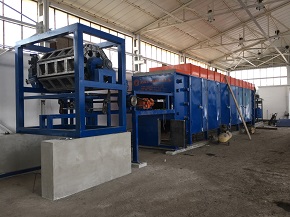3500 Pieces/ Hour Egg Tray Machine Production Line
-
1000 Pieces/ Hour Egg Tray Machine Production Line
-
2000 Pieces/ Hour Egg Tray Machine Production Line
-
3500 Pieces/ Hour Egg Tray Machine Production Line
-
AC_K4_2_5000 Violin Machine
-
6000-7000 Pieces /Hour Egg Tray Machine Production Line
-
EGG TRAY MOULDS
-
PRINTER
-
HOT PRESS
-
TECHNICAL DATA
-
ENERGY AND STAFF REQUIREMENTS OF MACHINES

3500 Pieces/ Hour Egg Tray Machine Production Line
Egg tray production facility
3500- PIECE / HOUR EGG TRAY PLANT MANUFACTURING
Line
Single Rotary, Octagonal 4-way Egg Viol Machine; 8 Floors 18 Mt Drying Line
Capacity
3500- pcs/hour
1.PULPER (DRUG PREPARATION) UNIT
Engine: 45 kW with belt and pulley
Volume:3 m³
Wave breaker and waste material discharge system available
There are 6 blade pulleys and the blades can be disassembled and mounted. This makes it easier to repair and maintain. (55-58HRC).
Vibrating sieve (6 mm hole)
It is made of D type body and 8 mm thick sheet metal.
Primer painted
2. FORM SECTION
Form Method: The pulp is shaped by vacuum given to the molds on the 8-gon and 4-way, single delayed machine.
Molds are made of aluminum
Capacity: 3500- pieces / hour (for 30 egg viols)
When you want to manufacture another product, all you have to do is change the molds. Mold change time takes approximately 1.5 hours.
Rotor lubrication and cleaning system. (recommended oil; mobil vatra no:2)
Our octagonal 4-way machine has 32 wire dies and 4 transfer dies.
Molds are processed by CNC.
Molds
Material: Aluminum
vacuum pump
90 kW
water ring
Stray Sieve
OVEN
4 way, 18 meters
8 floors and tunnel type
Product conveying system: Chain conveyor system
The wall thickness is 150 mm, insulated with 800 degree rock wool.
Fuel type: Natural gas or diesel
Temperature range: 100 °C - 600 °C
Ventilation: bidirectional (air discharge and air intake) airflow
There is automatic lubrication in the chains that provide product transfer.
The product transfer rate in the oven works simultaneously and automatically with the delay section.
According to customer preference, diesel or natural gas burners are used.
To provide easy air flow in the oven; product transfer, center weighted and galvanized coating and perforated pans are used.
conveyor chain; It is a pallet type flood roller and has a hardness of 50 HRC. (overflow roller definition: chain roller size is larger than chain size. This makes the chain move more easily)
Chain tension is provided by weight. Spring tension method is not used. When the inside of the oven starts to heat up, the chain lengthens. When tensioning is done with the spring, the tension of the chain on the right and left side of the oven cannot be provided equally. When tensioning is done with weight, the chain tension is provided equally on both sides. In this way, it is ensured that the system operates without malfunctions for a longer period of time.
Chain gear bearings are steel, oil-tight and 2-bearing.
There is a circulation fan in the oven. There is a water discharge system in the circulation fan. The steam formed in the oven is thrown out of the oven. Thus, easier drying is provided.
There is a steam suction unit in the air discharge chimney. The hot water obtained from the steam is sent to the dough boiler. Thus, hot water is obtained for the form part and there is no need to spend any energy for hot water.
The oven is systematically pre-tensioned. In this way, the necessary stretching is provided when the oven heats up or cools down.
There are hinged doors on the oven side walls. Door interiors are covered with fireproof wicks to prevent heat leakage.
HOW PRODUCTS ARE OBTAINED
Raw Material:
The raw material is mainly book, newspaper, magazine etc. waste paper; paper towel and napkin wastes, factory waste papers such as cardboard boxes and printing waste papers. The important thing is to ensure recycling by using waste paper. Thus, we both protect nature and gain profit.
Preparation of Paper Pulp:
The collected paper raw materials for the egg tray are put into the pulp preparation vessel (pulper). While the blades in the boiler break the raw material, water is supplied. Thus, a thick dough is obtained. The resulting dough is transferred to the thick dough holding boiler. In order for the product to be obtained to be of better quality; While the thick dough is transferred to the thick dough holding boiler, it is filtered through a straw sieve and foreign materials are removed. After this process, the dough is mixed with water to reach the desired consistency. Then, the dough obtained is transferred to the thin dough holding vessel.
Dough Forming:
Wire molds are dipped into the dough, which is transferred from the thin dough boiler to the chamber in the form section, and it is sucked by vacuum power. After it is transferred to the transfer mold, the transition to the pans that provide the transfer to the oven is provided. The excess dough and water in the delay chamber are transferred to the return tank and from there to the fine dough holding tank. Thus, waste of dough and water is prevented.
Drying:
The resulting wet product is transferred into the oven by means of a transfer conveyor for drying, and the products are dried. Then packaging is done.